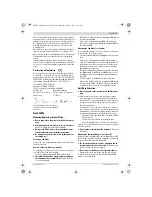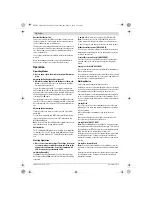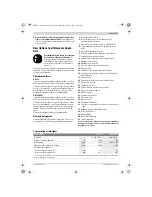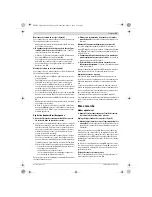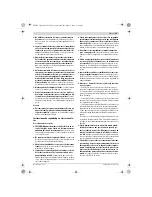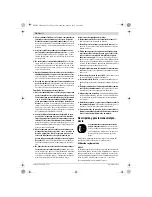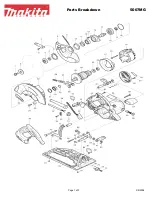
English |
15
Bosch Power Tools
2 609 932 939 | (21.5.14)
tion or kickback may occur.
Investigate and take correc-
tive actions to eliminate the cause of blade binding.
When restarting a saw in the workpiece, centre the saw
blade in the kerf and check that saw teeth are not en-
gaged into the material.
If saw blade is binding, it may
walk up or kickback from the workpiece as the saw is re-
started.
Support large panels to minimise the risk of blade
pinching and kickback.
Large panels tend to sag under
their own weight. Supports must be placed under the pan-
el on both sides, near the line of cut and near the edge of
the panel.
Do not use dull or damaged blades.
Unsharpened or im-
properly set blades produce narrow kerf causing excessive
friction, blade binding and kickback.
Blade depth and bevel adjusting locking levers must be
tight and secure before making cut.
If blade adjustment
shifts while cutting, it may cause binding and kickback.
Use extra caution when sawing into existing walls or
other blind areas.
The protruding blade may cut objects
that can cause kickback.
Lower guard function
Check lower guard for proper closing before each use.
Do not operate the saw if lower guard does not move
freely and close instantly. Never clamp or tie the lower
guard into the open position.
If saw is accidentally
dropped, lower guard may be bent. Raise the lower guard
with the retracting handle and make sure it moves freely
and does not touch the blade or any other part, in all angles
and depths of cut.
Check the operation of the lower guard spring. If the
guard and the spring are not operating properly, they
must be serviced before use.
Lower guard may operate
sluggishly due to damaged parts, gummy deposits, or a
build-up of debris.
The lower guard may be retracted manually only for
special cuts such as “plunge cuts and angle cuts”. Raise
the lower guard by retracting the handle and as soon as
the blade enters the material, release the lower guard.
For all other sawing operations, the lower guard should op-
erate automatically.
Always observe that the lower guard is covering the
blade before placing saw down on bench or floor.
An un-
protected, coasting blade will cause the saw to walk back-
wards, cutting whatever is in its path. Be aware of the time
it takes for the blade to stop after switch is released.
Additional safety warnings
Do not reach into the saw dust ejector with your hands.
They could be injured by rotating parts.
Do not work overhead with the saw.
In this manner you
do not have sufficient control over the power tool.
Use suitable detectors to determine if utility lines are
hidden in the work area or call the local utility company
for assistance.
Contact with electric lines can lead to fire
and electric shock. Damaging a gas line can lead to explo-
sion. Penetrating a water line causes property damage or
may cause an electric shock.
Do not operate the power tool stationary.
It is not de-
signed for operation with a saw table.
Do not use high speed steel (HSS) saw blades.
Such saw
blades can easily break.
Do not saw ferrous metals.
Red hot chips can ignite the
dust extraction.
When working with the machine, always hold it firmly
with both hands and provide for a secure stance.
The
power tool is guided more secure with both hands.
Secure the workpiece.
A workpiece clamped with clamp-
ing devices or in a vice is held more secure than by hand.
Always wait until the machine has come to a complete
stop before placing it down.
The tool insert can jam and
lead to loss of control over the power tool.
Products sold in GB only
: Your product is fitted with a
BS 1363/A approved electric plug with internal fuse (ASTA
approved to BS 1362).
If the plug is not suitable for your socket outlets, it should be
cut off and an appropriate plug fitted in its place by an author-
ised customer service agent. The replacement plug should
have the same fuse rating as the original plug.
The severed plug must be disposed of to avoid a possible
shock hazard and should never be inserted into a mains sock-
et elsewhere.
Products sold in AUS and NZ only
: Use a residual current de-
vice (RCD) with a rated residual current of 30 mA or less.
Product Description and Specifica-
tions
Read all safety warnings and all instruc-
tions.
Failure to follow the warnings and in-
structions may result in electric shock, fire
and/or serious injury.
While reading the operating instructions, unfold the graphics
page for the machine and leave it open.
Intended Use
GKS 55:
The machine is intended for lengthways and crossways cut-
ting of wood with straight cutting lines as well as mitre cuts in
wood while resting firmly on the workpiece. With suitable saw
blades, thin-walled non-ferrous metals, e. g., profiles, can al-
so be sawed.
Working ferrous metals is not permitted.
GKS 55 GCE:
The machine is intended for lengthways and crossways cut-
ting of wood with straight cutting lines as well as mitre cuts in
wood while resting firmly on the workpiece. With suitable saw
blades, thin-walled non-ferrous metals, e. g., profiles, light
uilding materials and plastic can also be sawed.
Working ferrous metals is not permitted.
Product Features
The numbering of the product features refers to the illustra-
tion of the machine on the graphics page.
OBJ_BUCH-244-007.book Page 15 Wednesday, May 21, 2014 11:05 AM

















